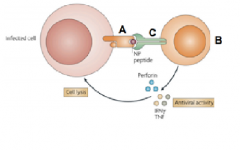![]()
![]()
![]()
Use LEFT and RIGHT arrow keys to navigate between flashcards;
Use UP and DOWN arrow keys to flip the card;
H to show hint;
A reads text to speech;
30 Cards in this Set
- Front
- Back
|
What are H and N in H1N1? |
Hemagglutinin (H) and Neuraminidase (N) |
|
|
'Hemagglutinin (H) and Neuraminidase (N)' Which of these mediates entry of the virus into cells of the respiratoryepithelia and which promotes viral release? |
Hemagglutinin (H) mediates entry and Neuraminidase (N) promotes release |
|
|
To which receptors on human respiratory epithelia does H1N1 bind? |
To those that have the α-2,6 sialic acid linkage to galactose |
|
|
Seasonal flu epidemics occur when point mutations accumulate in H and N.These point mutations lead to a process by which neutralising antibodies areunable to block entry of the virus into cells of the respiratory epithelia.What is this process known as? |
Antigenic drift |
|
|
Flu pandemics occur following genome re-assortment of avian and humaninfluenza viruses. In which mammalian host does genome re-assortmentoccur? |
Pig |
|
|
What feature of the respiratory epithelium of this mammal enables genome reassortmentof human and avian strains to occur? |
Avian viruses prefer the α-2,3 sialic acid linkage to galactose. Pigs expressboth α-2,3 and α-2,6 sialic acid linkages to galactose on respiratory epitheliathereby enabling binding and entry of both human and avian strains of the virus |
|
|
Name the 3 major components of innate immunity to viruses? |
Complement, Type 1 interferons, Natural Killer (NK) cells |
|
|
Major adaptive immunity to viruses is mediated via which cellular [1 mark] andhumoral [1 mark] components of immunity? |
CD8 (cytotoxic T cells/CTLs) and antibody |
|

What are A, B and C |
A = MHC Class I B = CD8 T cell C = T cell receptor |
|
|
Which cellular compartments of the cell does MHC class II monitor for foreign antigen? |
Compartments of the endosomal and lysosomal pathways |
|
|
Give an example of an effector function of complement, and name a keycomponent of complement that is directly involved in this effector function |
Inflammation – C3a C5a Opsonisation C3b Lysis (MAC) – C5-C9 |
|
|
How does the membrane attack complex cause bacterial killing? |
By forming pores in the bacterial cell wall |
|
|
What types of bacterial disease are associated with C9 deficiency? |
Meningitis and sepsis caused by Neisseria |
|
|
Give an example of a vaccine that induces antitoxin antibodies. |
Diphtheria, tetanus, anthrax, pertussis |
|
|
What is the traditional method for detoxifying the toxin before formulation into avaccine? |
Formaldehyde treatment |
|
|
How does this detoxification method work, at a molecular level? |
It causes the formation of inter- and intra-molecular cross-links between aminogroups in lysine and glutamine residues |
|
|
Give 2 of the problems associated with formaldehyde treatment |
Reversion, batch-to-batch variability, balance between loss of toxicity and lossof immunogenicity, production difficulties associated with the need to grow thepathogens and purify the toxin |
|
|
Explain briefly how biotechnology is helping to provide improved toxoid vaccines. |
Genetic toxoids are created, where the protein produced is non-toxic because of the substitution of a functionally critical amino acid |
|
|
Give an example of a bacterial polysaccharide that is targeted by a protective immune response. |
LPS O-antigens |
|
|
At the cellular immunology level, what is the main problem associated with theinduction of long-lasting immune responses to polysaccharides? How can this problem be solved? |
Lack of T-cell involvement By linking to a protein, to create a glyco-conjugate |
|
|
Tolerance is the process whereby self-reactive lymphocytes are removedor inactivated to avoid auto-immune disease. What are the 2 processes of cell killing and inactivation called? |
apoptosis and anergy |
|
|
What are the 2 possible outcomes for an immature B-cell that experiencesstrong binding to a multivalent self-antigen? |
apoptosis and receptor editing |
|
|
What is the fate of B-cells binding abundant soluble self-antigens in theperiphery? |
Anergy |
|
|
Name 2 of the cell types responsible for negative selection of T-cells in thethymus |
Dendritic cell or (medullary) epithelial cell or macrophage |
|
|
What are the 2 possible fates of a CD4+ T cell that interacts strongly with selfpeptide/MHCin the thymus? |
Clonal deletion/apoptosis or becoming a TREG cell |
|
|
Human RAG-1 Deficiency is caused by an autosomal recessive mutation whichdestroys the Recombinase Activating Genes. This deficiency results in whichdisease? |
T and B cell severe combined immunodeficiency (SCID) |
|
|
To what processes do the 12/23 and the WRC rules apply? |
The 12/23 rule applies to VDJ recombination activity whereby a 12 bp RSScan only recombine with a 23bp RSS through RAG1/2 protein recombinase. |
|
|
12/23 and the WRC Describe briefly their two different functions |
The cytosine in the WRC consensus is the preferential hotspot for AID cytosinedeaminase activity during SHM/CSR. |
|
|
what does AID stand for |
Activation Induced Deaminase |
|
|
Describe briefly the mechanism(s) through which AID contributes toantibody diversity. |
Somatic hypermutation (SHM) increases the affinity maturation of antibodies.Class switch recombination (CSR) increases effector function of antibodies |

